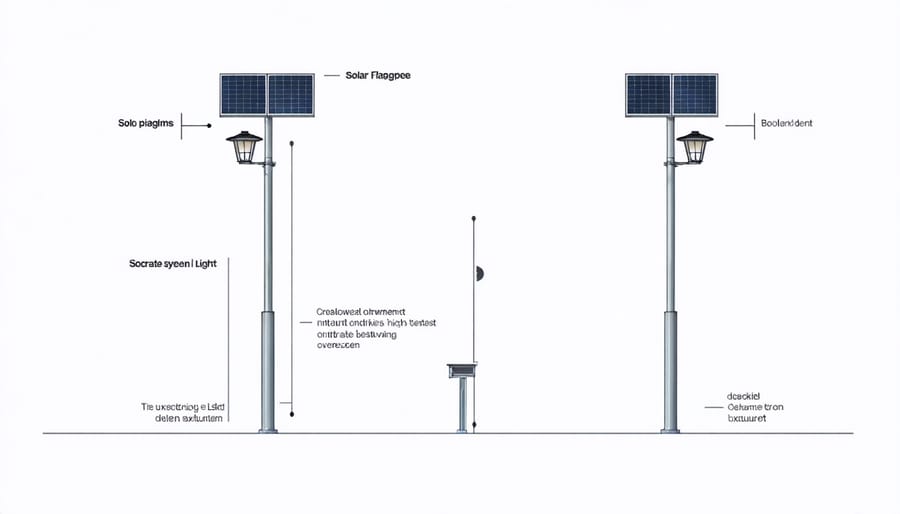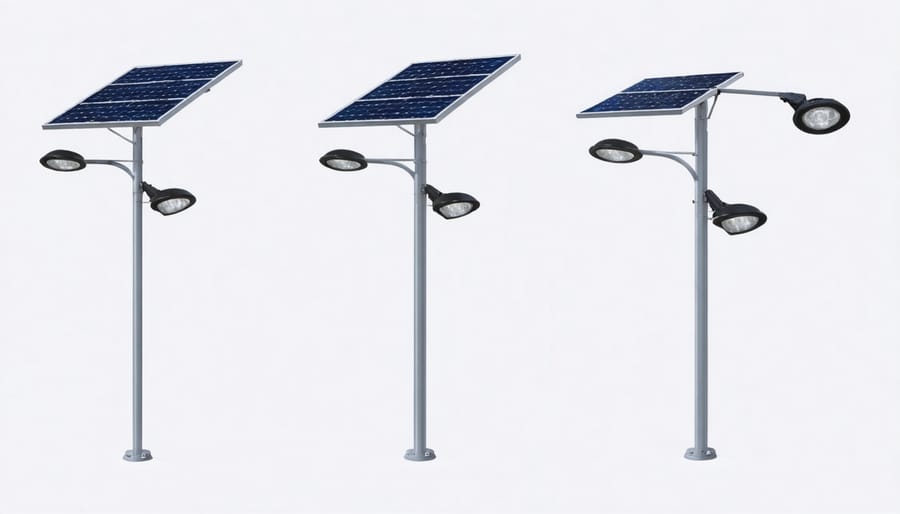Solar Flagpole Lights That Actually Keep Your Flag Visible All Night

Solar flagpole spotlights represent a transformative solution for those seeking to illuminate a flagpole effectively while embracing sustainable energy practices. These innovative lighting systems harness solar power to create dignified, continuous nighttime flag displays without increasing energy costs or requiring complex electrical installations. By combining high-efficiency LED technology with advanced photovoltaic cells, modern solar spotlights deliver reliable performance throughout Europe’s varying seasonal conditions. The latest generation of these systems features enhanced battery storage capacity, intelligent light sensors, and weather-resistant construction, ensuring year-round operation from Stockholm to Madrid. For businesses and homeowners committed to both patriotic display and environmental responsibility, solar flagpole illumination represents an elegant confluence of tradition and sustainable innovation.

How Solar Flagpole Spotlights Transform Night-time Display
Key Components of Modern Solar Flagpole Lights
Modern solar flagpole lighting systems integrate three essential components that work together to deliver long-lasting solar flagpole solutions. At the heart of these systems are high-efficiency LED arrays, typically featuring 6-12 powerful diodes that provide consistent, bright illumination while consuming minimal energy. These LEDs offer up to 50,000 hours of operation and produce a clean, white light that effectively highlights flags without creating light pollution.
The solar panels used in current systems employ monocrystalline silicon technology, offering superior energy conversion rates of up to 23%. These panels are specifically designed to capture both direct and ambient light, ensuring optimal charging even during cloudy European weather conditions. Most quality systems integrate panels rated between 2.5W and 5W, providing sufficient power for year-round operation.
The energy storage system typically consists of lithium-ion batteries, chosen for their excellent charge retention and performance in varying temperatures. Modern batteries feature capacities ranging from 2000mAh to 4000mAh, providing reliable illumination for 8-12 hours on a full charge. Advanced charge controllers protect these components, optimizing battery life and ensuring consistent performance throughout the seasons.

Smart Features for Reliable Performance
Modern solar flagpole spotlights incorporate intelligent features that ensure reliable performance throughout the year. At the heart of these systems are photosensors that automatically activate the light at dusk and deactivate it at dawn, eliminating the need for manual operation. This smart technology adapts to seasonal changes in daylight hours, providing consistent illumination when needed.
Advanced timing systems offer customisable operation modes, allowing users to optimise energy consumption based on specific requirements. Many models feature multiple brightness settings and timing intervals, ensuring efficient power usage while maintaining proper flag illumination standards.
Weather resistance is a crucial aspect of these fixtures. Premium spotlights are engineered with IP65 or IP67 ratings, protecting against rain, snow, and dust. The solar panels are typically covered with tempered glass and anti-UV coating, preventing degradation from prolonged sun exposure. The housing materials, often crafted from high-grade aluminium or durable ABS plastic, resist corrosion and withstand extreme temperatures from -20°C to 60°C.
These smart features work together to deliver year-round performance while minimising maintenance requirements, making solar flagpole spotlights a reliable solution for continuous flag illumination.
Installation and Positioning for Maximum Effect
Optimal Placement Guidelines
For optimal performance of your solar flagpole spotlight, precise placement is crucial. Position the solar panel facing south in the Northern Hemisphere (or north in the Southern Hemisphere) to maximise sunlight exposure throughout the day. The ideal angle for the solar panel typically matches your geographical latitude, though adding 10-15 degrees during winter months can improve efficiency.
Install the spotlight at a distance of 2-3 metres from the flagpole base, ensuring unobstructed illumination of the entire flag. The mounting height should be approximately one-third of the flagpole’s total height for balanced lighting distribution. Consider seasonal flag movement patterns when determining the final position to maintain consistent illumination throughout the year.
Avoid locations near trees, buildings, or other structures that could cast shadows on the solar panel during peak sunlight hours. For areas with significant snowfall, consider elevated mounting options to prevent snow accumulation on the panel. The spotlight head should be adjustable to fine-tune the beam angle, typically between 30-45 degrees upward, depending on flagpole height and flag size.
Remember to account for local weather patterns and adjust accordingly to ensure reliable year-round performance.
Professional Installation Tips
Begin by selecting a secure mounting location that receives ample sunlight throughout the day. The ideal spot should be within 2-3 metres of your flagpole, ensuring optimal illumination coverage. Clear any obstacles that might cast shadows on the solar panel.
For ground installation, dig a hole approximately 30cm deep and fill it with 10cm of gravel for drainage. Insert the mounting pole and secure it with quick-drying concrete, ensuring it’s perfectly vertical using a spirit level. Allow 24 hours for the concrete to cure completely.
When mounting on existing structures, use sturdy stainless steel brackets and weatherproof fixings suitable for your surface material. Position the solar panel at a 30-45 degree angle, facing south for maximum sun exposure in European latitudes.
Connect the wiring following the manufacturer’s colour-coding, ensuring all connections are weatherproof. Use UV-resistant cable ties to secure loose wiring, creating a neat installation that withstands environmental conditions.
Test the system during daylight hours to confirm proper charging, then check illumination at dusk. Adjust the spotlight angle to achieve even flag coverage, typically around 120 degrees upward. Finally, verify all mounting points are secure and weatherproof seals are properly seated.

Maintenance and Performance Optimization
Seasonal Adjustments
Optimising your solar flagpole spotlight for different seasons ensures reliable illumination throughout the year. During summer months, when daylight hours are longer, adjust the spotlight’s angle slightly downward to maximise sunlight exposure during peak hours. The solar panel typically performs best at a 30-45 degree angle in European latitudes during this season.
For winter operations, increase the panel angle to approximately 60 degrees to compensate for the sun’s lower position. This adjustment helps capture more direct sunlight during shorter days. Consider cleaning the solar panel more frequently during autumn when fallen leaves and debris might reduce efficiency.
In regions experiencing heavy snowfall, install a protective cover over the spotlight while maintaining panel exposure. During particularly cloudy periods, switch to a lower brightness setting to conserve energy and extend illumination time. Most modern solar spotlights feature automatic adjustment capabilities, but manual optimisation can significantly improve performance.
For rainy seasons, ensure all weatherproof seals are intact and functioning properly. Some models offer specific weather modes that adjust light intensity based on available stored power, helping maintain consistent illumination regardless of weather conditions.
Troubleshooting Common Issues
If your solar flagpole spotlight isn’t performing optimally, several straightforward solutions can address common lighting issues. First, ensure the solar panel is free from dust, leaves, and debris that may obstruct sunlight absorption. Regular cleaning with a soft, damp cloth can significantly improve performance. Check that the light sensor isn’t blocked or affected by nearby artificial lighting, which could prevent automatic activation at dusk.
Battery performance issues often arise during extended cloudy periods. Consider adjusting the spotlight’s position to maximize sun exposure during peak hours. If the light dims quickly, the batteries might need replacement – typically necessary every 18-24 months for optimal performance.
For mounting-related problems, verify all brackets and fasteners are secure and properly aligned. In regions with frequent rainfall, ensure water drainage holes aren’t blocked to prevent moisture accumulation. During winter, snow accumulation on solar panels can severely impact charging efficiency – regular clearing is essential for continuous operation.
If these steps don’t resolve the issue, check the wiring connections for signs of corrosion or damage, particularly in coastal areas where salt air can accelerate deterioration.
European Compliance and Standards
Solar flagpole spotlights sold in the European market must comply with several key regulations and quality standards to ensure safety, reliability, and environmental sustainability. The CE marking is mandatory for these products, indicating conformity with the EU’s health, safety, and environmental protection standards. This certification covers both the solar panels and the LED lighting components.
Products must adhere to the RoHS (Restriction of Hazardous Substances) Directive 2011/65/EU, which restricts the use of specific hazardous materials in electrical and electronic equipment. The WEEE (Waste Electrical and Electronic Equipment) Directive 2012/19/EU also applies, ensuring proper disposal and recycling procedures are in place.
For outdoor lighting applications, solar flagpole spotlights must meet the IP65 or higher rating under IEC 60529, guaranteeing protection against dust and water jets. The EN 62471 standard for photobiological safety of lamps ensures the LED components pose no risk to human eyes or skin.
The solar components must comply with IEC 61215 for design qualification and type approval, while batteries should meet EN 62133 standards for safety requirements. Additionally, these products fall under the Ecodesign Directive 2009/125/EC, promoting energy-efficient design principles.
European manufacturers and distributors must provide clear documentation, including Declaration of Conformity (DoC), technical specifications, and user manuals in relevant European languages. Regular testing and certification updates ensure continued compliance with evolving European standards, maintaining the highest levels of quality and safety for consumers.
Proper flag illumination represents more than just adherence to flag etiquette; it embodies respect for national symbols while embracing sustainable technology. Solar flagpole spotlights offer an elegant solution that combines tradition with innovation, providing reliable illumination without increasing energy costs or environmental impact. Through our exploration of these systems, we’ve seen how modern solar technology has evolved to offer dependable performance even in variable European weather conditions.
The key to success lies in selecting the right components, considering factors such as lumens output, battery capacity, and mounting options. Professional installation ensures optimal positioning for maximum solar collection and proper flag illumination, while regular maintenance keeps the system performing at its best. By choosing solar-powered flag lighting, property owners make a statement about their commitment to both tradition and sustainability.
As Europe continues its transition toward renewable energy solutions, solar flagpole spotlights represent a small but meaningful step in the right direction. They prove that even traditional displays can benefit from modern, eco-friendly innovations, offering reliable performance while contributing to a more sustainable future.
Leave a Reply